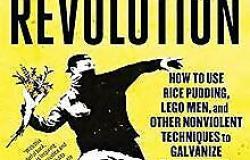What Tactics are most Effective in Non-Violent Protest?

Duncan Green unpicks new research on what works for Protest Movements.
I met (albeit via zoom and Global Policy's Tom Kirk) with Srjda Popovic, one of my protest heroes, last week. Srdja’s Serbian political activist who cut his activist teeth as a leader of the student movement Otpor that helped topple Serbian president Slobodan Milošević. He established the Centre for Applied Nonviolent Action and Strategies (CANVAS) in 2003 and published Blueprint for Revolution in 2015, which is when I first heard about him. Do read it (reviewed here) – it’s brilliant.
Srdja is now in the US, mixing activist training and academia (he calls himself a ‘semi academic’ – might nick that). We were setting up a podcast for a training course we are designing for Middle East civil society leaders (watch this space). In preparation he sent the link to a fascinating paper he wrote with Sophia McClennen and Joseph Wright on ‘How to Sharpen a Non-Violent Movement’. Here’s the gist:
 The abstract: ‘In the past three decades nonviolent social protest has become the most reliable path to democracy. However, not all nonviolent mobilization campaigns succeed. To examine why some nonviolent campaigns are more successful than others, we analyze the use of a particular type of activist campaign tactic, the “dilemma action.” The dilemma action is a nonviolent civil-disobedience tactic that provokes a “response dilemma” for the target. Collecting original data on dilemma actions during nonviolent activist campaigns, we find that roughly one-third of mass nonviolent campaigns in the past century deploy this strategy. We theorize four mechanisms linking dilemma actions to nonviolent activist campaign success: facilitating group formation, delegitimizing opponents, reducing fear, and generating sympathetic media coverage. Finally, we assess whether dilemma actions increase campaign success rates, finding that dilemma actions are associated with an increase of 11–16 percent in activist-campaign success.’
The abstract: ‘In the past three decades nonviolent social protest has become the most reliable path to democracy. However, not all nonviolent mobilization campaigns succeed. To examine why some nonviolent campaigns are more successful than others, we analyze the use of a particular type of activist campaign tactic, the “dilemma action.” The dilemma action is a nonviolent civil-disobedience tactic that provokes a “response dilemma” for the target. Collecting original data on dilemma actions during nonviolent activist campaigns, we find that roughly one-third of mass nonviolent campaigns in the past century deploy this strategy. We theorize four mechanisms linking dilemma actions to nonviolent activist campaign success: facilitating group formation, delegitimizing opponents, reducing fear, and generating sympathetic media coverage. Finally, we assess whether dilemma actions increase campaign success rates, finding that dilemma actions are associated with an increase of 11–16 percent in activist-campaign success.’
The big idea here is the ‘dilemma action’, designed to create a dilemma for the target and force opponents into a “lose-lose” situation: Whatever the opponents do, they will suffer reputational harm and end up looking bad. A well-chosen dilemma action taps into widely held beliefs and uses unpredictability and humour (‘autocrats to not like jokes’) to destabilize the official narrative and attract widespread public support.
The classic example (there are lots more wonderful examples in the paper and Blueprint for Revolution) is Gandhi’s salt march: ‘During their colonial occupation of India, British authorities held monopoly control over the vital everyday staple of salt, taxing it and controlling its production and distribution with an eye toward its value as an export. The independence movement could have angrily protested this state of affairs, but instead chose to do something far more creative. Led by Mohandas K. Gandhi, independence activists marched to the coast and began evaporating seawater to make their own salt. Tax protests and noncompliance soon spread across India and affected many things besides salt.
The British authorities found themselves in a bind: They could watch their control over salt (and more) go away, or they could launch a crackdown. They chose the latter, arresting thousands and along the way harming the colonial regime’s legitimacy, sparking an international outcry, and giving the independence movement additional momentum.’
But let’s get onto the academic bit. The authors use Harvard’s database on large non-violent and violent campaigns and outcomes (NAVCO) from 1905-2019 and go through it identifying which involved dilemma actions and which didn’t (for example, they were simply protest movements). They find that DAs occur in about a third of non-violent campaigns. They find that non-violent campaigns with a dilemma action are significantly more likely to ‘succeed’ (see bar chart). I have my doubts about the stats – coding for creativity makes me queasy, and there are other possible explanations such as better write-ups demonstrating both dilemma actions and more success. But let’s move on, because there is more of interest in the findings.
‘The difference in success rates has narrowed over the last three decades, however, just as the overall success rate for nonviolent campaigns has dropped. Both these trends—the smaller difference made by dilemma actions, and nonviolent campaigns succeeding more rarely overall—seem to have started as the Cold War was ending. For much of the twentieth century, including the years from 1920 to 1950, we see a success rate for dilemma-action–inclusive campaigns that substantially outstrips the success rate of campaigns lacking a dilemma action. In the three decades or so since the Cold War ended, however, the difference shrinks. Specifically, it goes from 25 points between 1905 and 1988 to 9 points since that latter year: From 1989 through 2019, nonviolent campaigns with at least one dilemma action succeeded in 61 percent of cases, while campaigns without succeeded 52 percent of the time.’
The explanation turns out to be that DAs are more effective in more autocratic countries (they crunch the numbers to prove it), and these have subsided over time. It may also be (this is me, not them) that just as autocrats have got better at manipulating elections, they have also learned how to deal with DAs – the bad guys aren’t stupid and keep learning, unfortunately.
The coding also identifies four specific elements of dilemma actions that shape nonviolent-campaign success: facilitating group formation, delegitimizing opponents, reducing fear, and generating sympathetic media coverage (more so than other kinds of non-violent protest).
To end, a nice example from Belarus, and a sensible caveat:
‘In Belarus in 2011, activists were able to agitate the regime of President Alyaksandr Lukashenka by simply clapping in public. When his police arrested some of them, the public saw a heavily armed authoritarian government with every means of coercion at its disposal revealing its fear of peaceful protest.’
‘Will these creative tactics force the regimes in Russia, China, and Iran to end their aggressive policies? Probably not. But can such approaches harm these regimes’ authority and popularity? Our research shows that there is a decent chance for both to suffer damage.’
Great stuff, do please read the paper.
P.S. When we discussed this with our LSE students, we ended up comparing Gandhi and Just Stop Oil. JSO is working with v limited resources to get an issue in the public eye, but it is not ‘doing a salt march’ in terms of putting anyone (except its activists and maybe liberal onlookers) in a dilemma. What might some dilemma actions (for companies or governments) on ending fossil fuel extraction look like?
This post first appeared on From Poverty to Power and was reposted with permission.


